#Auguste Mariette
Text
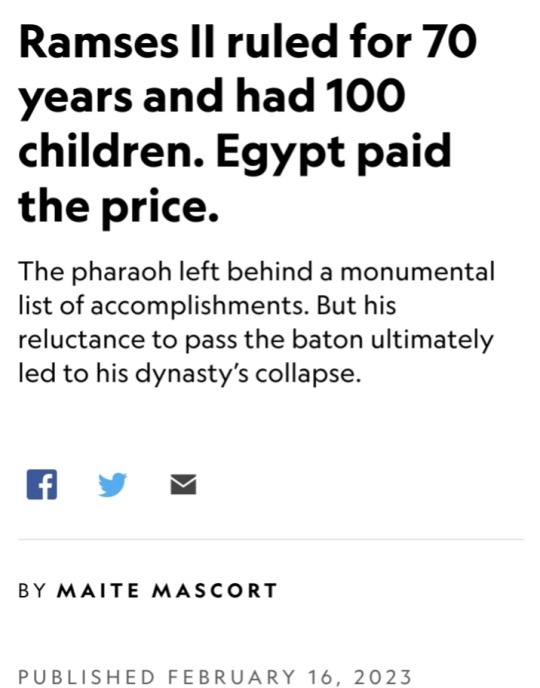

Few individuals in Egypt’s history have aroused as much curiosity, and as much skepticism, as Ramses II, third pharaoh of the 19th dynasty, whom history dubbed Ramses the Great.
Today, Ramses II is probably best known for leaving behind a monumental set of works — palaces, temples, statues, stelae — each one extolling his pharaonic achievements.
Every battle was a mighty triumph, every building spectacular, every statue and public work magnificent, every act a near superhuman achievement.
Ramses’ family came to power as outsiders.
They were northerners hailing from the Nile Delta and rose through military service, rather than southerners rising from elite circles in Thebes.
To rally support, Ramses II used these massive monuments to appeal to the people as part of a campaign to proclaim his greatness for all to see.
Ramses lived around 90 years and ruled for almost 70.
Thanks to his building campaigns, Egyptologists know much about his public accomplishments, but questions about his wives and children still remain.
Great royal wives
One of the most striking aspects of Ramses II’s story is the women who surrounded him:
Great royal wives and concubines, secondary wives and daughters, whom he sometimes “married,” for political show or perhaps for real.
He produced an extraordinary number of sons and daughters:
Some records say as many as a hundred. Because of his long reign, many of his children predeceased him.

Out of all of his wives, only two were known to have had prominent roles:
Nefertari and Isetnofret, the first two named great royal wives.
While the former figures prominently in Egyptian sources and countless representations of her exist, little is known of the latter, almost as if Ramses wanted her hidden.
It is only natural to wonder about the reasons for such unequal treatment.
When he became co-regent with his father, Seti I, Ramses II received a palace in Memphis, just south of the Nile Delta, and a large harem, including the first two great royal wives.
The origins of Nefertari and Isetnofret are unknown but that has not prevented the wildest of speculation about them.
Everything suggests that Nefertari was Ramses II’s favorite wife. Her beauty is attested to in the statues and paintings in her tomb in the Valley of the Queens.
However, it is uncertain what she actually looked like, since some images raise doubts about who is depicted.

For example, in Karnak, a small statue of Nefetari stands at the foot of a colossus representing Ramses II, her husband.
The colossus was later usurped by Pharaoh Pinedjem I, who had his name inscribed on it, and the features of both figures may have been modified.
Was only the name changed? Is that beautiful face still Nefertari’s? Egyptologists believe so.
Nefertari took part in official events alongside Ramses.
She was shown celebrating his coronation, in festivities of the god Min, and in Nebunenef’s enthronement as High Priest of Amun.
Her diplomacy culminated in a peace treaty between Ramses and the Hittites several years after the Battle of Kadesh (1274 B.C.) had resulted in a stalemate between the two powers.
Ramses II showed a clear predilection for Nefertari, devotion worthy of a great love story.
When he built the great temple of Abu Simbel, he made sure that Nefertari, then deceased, was on the facade, next to Tuya, his mother.

In this temple, Nefertari is transformed into Sopdet, the star Sirius, whose appearance presaged the Nile’s annual flooding.
Farther north, another smaller temple dug into rock is dedicated to Nefertari herself.
There, she is identified with the goddess Hathor. Carved into its facade is a tribute:
“Nefertari, she for whom the sun shines.”
Was Isetnofret the forgotten one? So it seems.
Until Nefertari died, around year 26 of Ramses II’s reign, Isetnofret’s likeness did not appear in the many temples the king built in Nubia, nor in those in Karnak and Luxor, where Nefertari is often portrayed.
Isetnofret was finally represented in some temples for her connection with her children.
Nefertari’s image may be seen in more places, but it was Isetnofret who bore her husband the two children closest to his heart.

Sons and daughters
Ramses II had a hundred or so sons and daughters with the wives in his harem.
Of his recognized children, some would play important roles, but only those born to Nefertari and Isetnofret appear on his monuments.
In the Nubian temple of Beit el Wali, a young Ramses, then co-regent with his father, Seti I, is shown suppressing a Nubian uprising.
The pharaoh’s royal chariot is flanked by two figures identified as Amenherkhepshef, his eldest child with Nefertari, and Khaemwaset, Isetnofret’s son.
Of all Ramses II’s sons, Khaemwaset is believed to have been his favorite.
Instead of taking up arms against his elder brother (also named Ramses), Khaemwaset became Grand Master of the Artisans of Ptah, a title in Memphite doctrine equivalent to High Priest of Amun in Thebes.
He also restored a number of pyramids in his father’s name. His work is still evident on the pyramid of Unas, from the 5th dynasty.
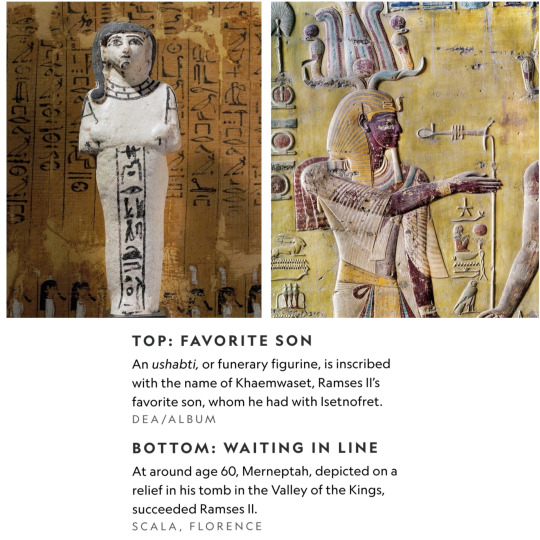
Khaemwaset also planned and directed the work of the “minor galleries,” the Serapeum at Saqqara, the collective tomb of the Apis, sacred oxen of Memphis.
Auguste Mariette’s 1850 excavation of the Serapeum revealed the mummy of a man named Khaemwaset, wearing a golden mask with several ushabtis.
It proved uncertain that it was the mummy of Ramses II’s son, and the location of Khaemwaset’s tomb remains unconfirmed. Much evidence suggests that it is in the necropolis of Saqqara.
The daughters of Ramses II’s great royal wives also held key positions in his court.
In fact, many became great royal wives themselves after marrying their own father.
It had become customary for 18th-dynasty pharaohs to marry their daughters.
While his great royal wife Tiye was alive, Amenhotep III married their daughter Sitamun.
Later, Akhenaten married at least two of the daughters he had with Queen Nefertiti.
No one knows if these marriages were consummated or purely ceremonial.

Ramses II appointed several daughters / great royal wives after the deaths of Nefertari and Isetnofret.
Bintanah (Isetnofret’s firstborn) was followed by Merytamon and Nebettawy (daughters of Nefertari) and Henutmire.
In addition to these daughters, other princesses outside the family also bore the title of Great Royal Wife, such as Maathorneferure, daughter of the Hittite king, and another Hittite princess whose name is unknown.
If Khaemwaset was Ramses II’s favorite son, everything points to Bintanath having been his preferred daughter.
She was given the titles of not only Great Royal Wife but also Lady of the Two Lands and Sovereign of Upper and Lower Egypt.
Bintanath occupies a privileged place on the facade of the temple of Abu Simbel. She and her sister Nebettawy appear on either side of the colossus.
Some historians believe Nebettawy’s mother was Isetnofret, but others consider her Nefertari’s daughter.
Fractured legacy
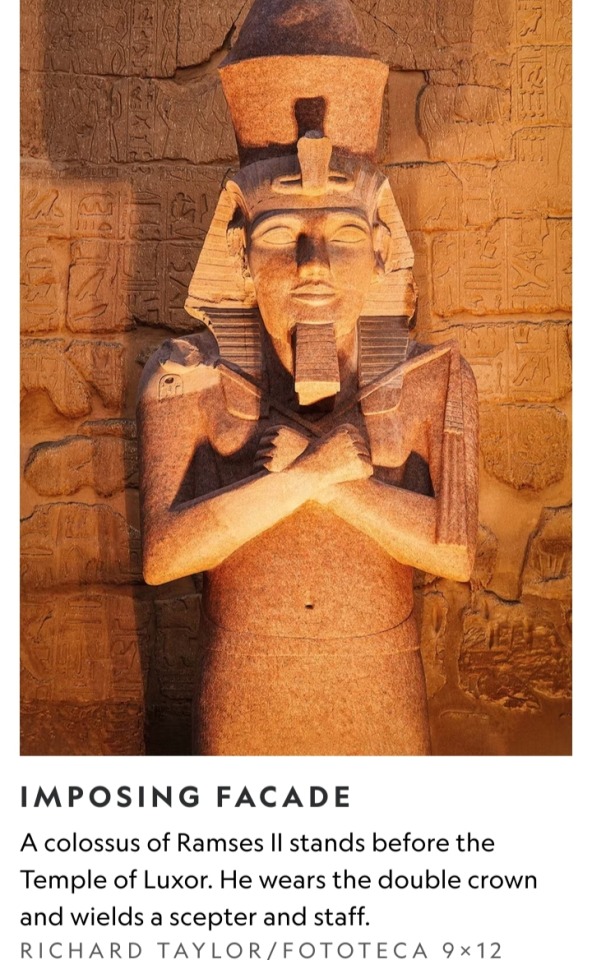
Ramses had no problems siring heirs with his many wives during his long life, but these sons would be forced to be patient; their father held tightly to his throne for almost 70 years.
Ramses had placed his children liberally throughout Egypt’s bureaucracies, corporations, priesthood, and military to foster loyalty he did not naturally inspire.
He was an outsider, a northerner hailing from the Nile Delta, disconnected from the wealthy elites in southern Thebes.
Ramses’ source of strength rested on ties to, not the moneyed or religious classes, but the military. Placing his sons in powerful positions across Egypt helped strengthen Ramses’ hold in these areas.
By the time Ramses II died in 1213 B.C., he was around 90 years old and had outlived many of these sons.
Amenherkhepshef, Ramses’ oldest son and crown prince, died when he was 25 years old.
Khaemwaset also did not outlive his great father and died in his mid-50s around 1215 B.C.
It would be a child of Isetnofret, her son Merneptah, who was 13th in line, who succeeded Ramses.
Merneptah was around 60 years old, well past middle age, when he became pharaoh and donned Egypt’s double crown.
After decades of waiting in the wings to take power, Merneptah might have expected a stable reign, like his father’s, but his hopes were in vain.
During his 10-year reign, his troops were able to defend Egypt successfully from a series of attacks from enemies in the east and west.
But the seeds sown by Ramses II would lead to chaos after Merneptah’s death.
Rivals for the throne, some of whom may have been sons of Ramses II, pushed Egypt into a period of decline and civil war.
By around 1189 B.C., the 19th dynasty would come to an end.

#Ramses II#Ramses the Great#Nefertari#Isetnofret#Seti I#Valley of the Queens#Pharaoh Pinedjem I#Hittites#Battle of Kadesh#Abu Simbel#Tuya#Amenherkhepshef#Khaemwaset#Auguste Mariette#Bintanath#Ancient Egypt#Egyptian Civilization#Egypt#egyptologist#Egyptology#Nineteenth Dynasty of Egypt#19th Dynasty of Egypt
19 notes
·
View notes
Text

A Lost 4,400-Year-Old Tomb Found With Ancient Egyptian Mummy Inside
Archaeologists have rediscovered a lost tomb that contains the mummy of an ancient Egyptian official.
The tomb belonged to Ptahshepses, who lived around 4,400 years ago during the 25th and 24th centuries B.C. Archaeologists with the Czech Institute of Egyptology at Prague's Charles University said this week they located the tomb near the archaeological sites of Abusir and Saqqara in 2022 by using satellite imagery and studying old maps. Further excavations were conducted at the site this year.
The tomb was partially exposed almost 160 years ago by the French scholar Auguste Mariette, who uncovered an intricately decorated false door with a lintel, or a kind of supporting beam. But not long after the discovery, the tomb disappeared under the desert sand.
The false door and lintel contain information about Ptahshepses' official career, telling the story of his education at the court of Menkaure, an ancient pharaoh who was born in 2532 B.C. and died in 2504 B.C.
According to the information on the false door, Ptahshepses married the daughter of Userkaf, a pharaoh who reigned for a short period in the early 25th century B.C.
This reference itself indicates that Ptahshepses is the first known official of non-royal descent in Egyptian history who was given the privilege of marrying a royal daughter," the Czech Institute of Egyptology said in a Facebook post.


In addition, on the lintel there is a reference that is one of the earliest attestations of the deity Osiris, the god of fertility and the embodiment of the dead.
"This makes the official Ptahshepses even more unique because he can be credited with the idea of introducing the famous god of the Egyptian afterlife into the Egyptian pantheon," the Facebook post said. "Given Ptahshepses' political, historical and religious significance, the tomb is one of the most remarkable discoveries of the recent periods in Egyptian archaeology."
Excavations at the site uncovered an extensive, 137-foot-long and 72-foot-wide superstructure of the tomb. It includes a relatively well-preserved chapel with painted decoration in the entrance and a long access corridor.
This past spring, archaeologists examined the burial chamber, which appeared to have been robbed in antiquity. Nevertheless, it still featured some original funerary artifacts (including pottery), the remains of votive offerings, jars and a mummified fish.
In addition, researchers found a partially opened sarcophagus with the complete mummy of Ptahshepses inside.
Examination of the mummy by Egyptian anthropologists has provided important new data on the evolution of mummification during Egypt's Old Kingdom, which lasted from around 2700 B.C. to 2200 B.C.
One of the researchers, Miroslav Barta, said in a statement: "The tomb of a man who changed the course of Egyptian history has been rediscovered, representing one of the expedition's greatest recent discoveries. The research is still ongoing, and further discoveries will likely be made to shed new light on his family and times."
By ARISTOS GEORGIOU.
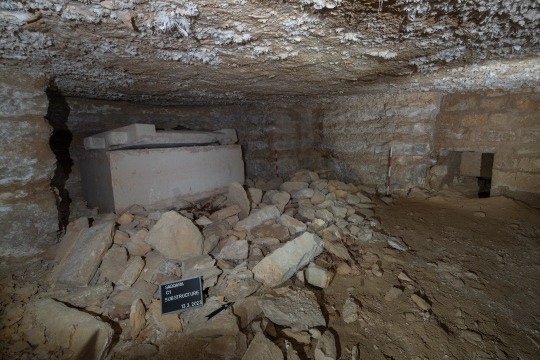
#A Lost 4400-Year-Old Tomb Found With Ancient Egyptian Mummy Inside#Ptahshepses#French scholar Auguste Mariette#ancient grave#ancient tomb#ancient artifacts#archeology#archeolgst#history#history news#ancient history#ancient culture#ancient civilizations#ancient egypt#egyptian history
92 notes
·
View notes
Text
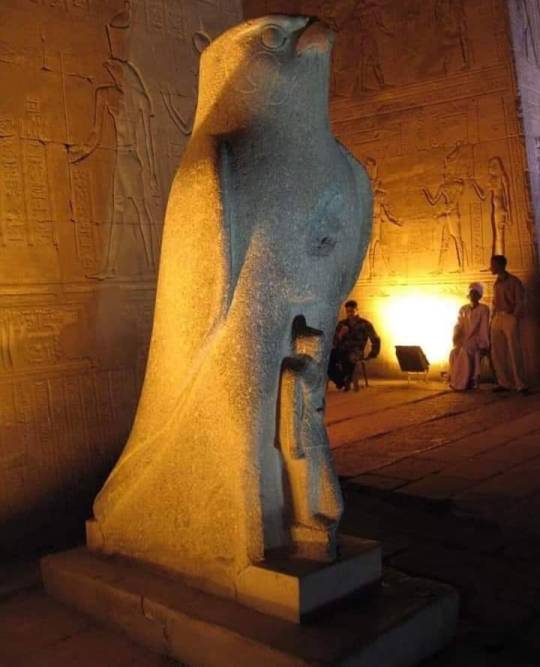
Edfu Temple
Built from 237 – 57 BCE
The Temple of Edfu was buried under centuries of sand and silt until the nineteenth century, when French Egyptologist Auguste Mariette rediscovered the site. The complex is one of the most well-preserved sites in Egypt today; its architecture is very much intact, and the building contains a wealth of legible inscriptions on its walls. It is dedicated to the falcon god, Horus.
181 notes
·
View notes
Text
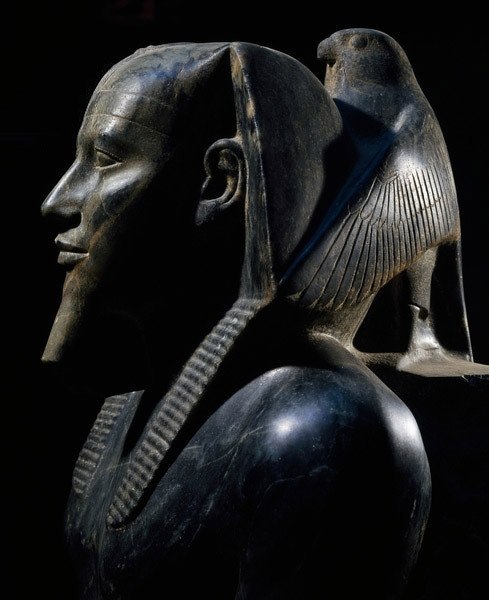
Khafre Enthroned
The purpose of the statue was to legitimize and celebrate the universal authority of the king, of whom the throne was one of the most powerful expressions, as the guarantor of the stability and unity of the country.
The concept is further emphasized by the presence of the falcon-god Horus, who protects the head of the king between his wings as though to underline the perfect symbiosis of the man and the god.
Old Kingdom, 4th Dynasty, around 2570 BC. Made out of anorthosite gneiss (related to diorite). Excavation by Auguste Mariette (1860)From the Valley Temple of Khafre. To be in the Grand Egyptian Museum, Giza. JE 10062
Read more
122 notes
·
View notes
Text

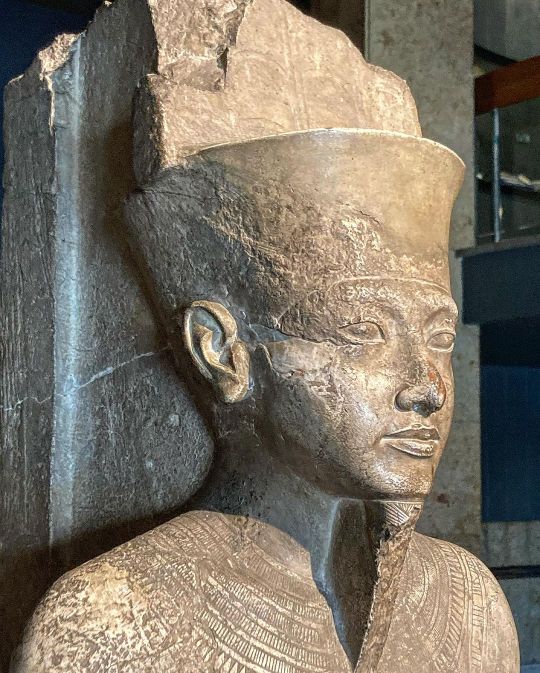

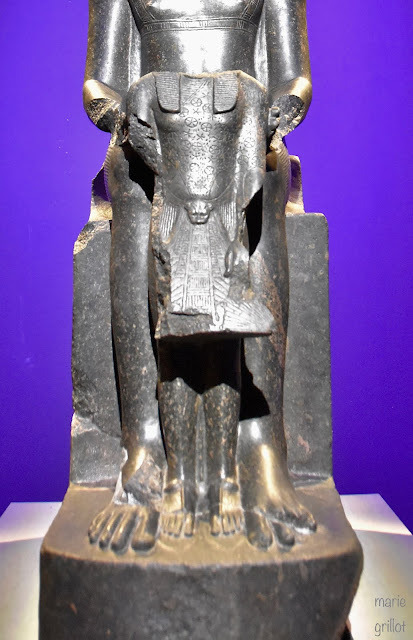
The god Amun protects Tutankhamun – 1336 – 1327 BC – diorite.
Statue discovered by Auguste Mariette in Karnak in 1857
Collection of Prince Napoleon then Maison Feuardent
Acquired by the Louvre Museum in February 1920 – E 11609
Dated 1336 – 1327 BC, 2.15 m high, this statue is carved in the round from a block of very dark diorite. The “polish”, as impeccable as it is admirable, given to it by the sculptor seems to have attenuated its dark side, even giving it a shiny appearance. Georges Bénédite, who devoted a long study to this statue, brings this clarification: “We see at the top of the supporting pillar like a trail of pink granite, the witness of the vast syenite bank where the black rock flow was imprisoned”.
The statuary group represents the god Amun, seated on a cubic throne, with his hands resting as a sign of protection on the shoulders of Tutankhamun, who is standing in front of him and who is represented on The “symbolism” of the statue lies in the attitude that the god manifests to the sovereign: he, in fact, gives him “the investiture, because, the divine gesture is both of protection and presentation”. As Jacques Vandier translates it so well: “Amon stretches out his arms and puts his hands on the king’s arms. The divine hands were intentionally broken by sectarians who wanted, thereby, to prevent the divine fluid from permeating the former partisan of Aten. They also are who, without doubt, beheaded Tutankhamun “.
He is dressed in a tunic – or corselet – whose straps and braid are decorated with delicately chiselled friezes. The pleated loincloth leaves the navel visible. It is held at the waist by a nicely crafted belt which has an oval pattern in its centre under which is reproduced an Isis knot.
His body is of ideal proportions, with square shoulders and: “powerful legs, which help to accentuate the impression of strength and stability”.
#egyptian#egyptphotography#african history#egyptshots#kemet#prince of egypt#ancient egypt#egypt#tutankhamun#ancient history#egyptology#Amun#gods of egypt#pyramids#egyptian mythology
34 notes
·
View notes
Photo
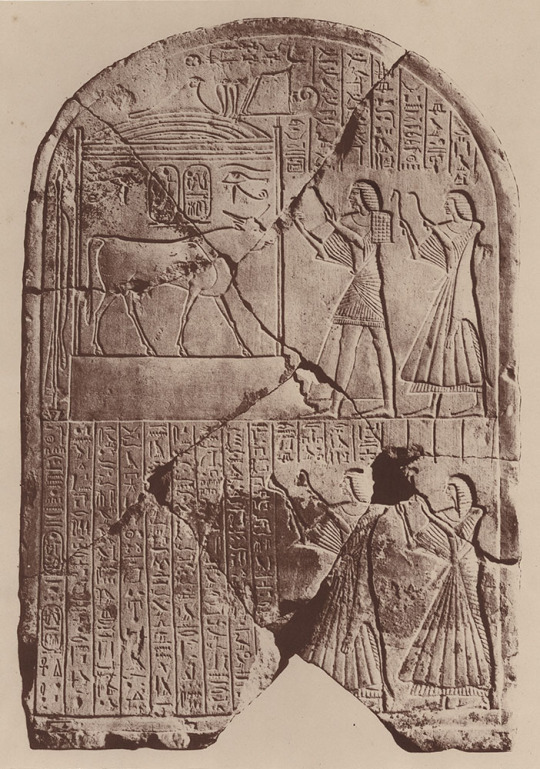
Paul Marcellin Berthier, Twelve Plates of Egyptian Objects from "Le Serapeum de Memphis / découvert et décrit par Auguste Mariette", 1857-66
110 notes
·
View notes
Text

date: august 2020
remembered mariette again months later, so i once again tried to draw her while grounded but on ms paint this time, then forgot about her again
this has got to be my very first digital drawing of mari in like 4 years,,,
7 notes
·
View notes
Photo

TV Guide - July 6 - 12, 1963
Martin Sam Milner (December 28, 1931 – September 6, 2015) Film, stage, radio and television actor. Milner is best known for his performances in two popular television series: Route 66, which aired on CBS from 1960 to 1964, and Adam-12, which aired on NBC from 1968 to 1975.
He guest starred in many television series during the 1950′s through the 1990′s. Among them were The Stu Erwin Show, Dragnet, The Life of Riley, Navy Log, 7 The West Point Story, Wagon Train, The Millionaire, Rawhide, The Twilight Zone, Laredo, The Virginian, Fantasy Island, MacGyver, Murder, She Wrote and Life Goes On. He also starred in The Swiss Family Robinson during the 1975-1976 season. (Wikipedia)
Glenn Corbett (born Glenn Edwin Rothenburg; August 17, 1933 – January 16, 1993) Actor in movies and television for more than thirty years. Corbett came to national attention in the early 1960s when he replaced George Maharis in the cast of the popular CBS adventure drama Route 66. He followed this with roles in high-profile films and television shows, including a guest role in the original Star Trek series, the daytime soap opera The Doctors and the prime-time soap Dallas.
In 1963, Corbett replaced George Maharis on Route 66. Corbett, playing Lincoln Case, co-starred with Martin Milner during part of the third season and the fourth and final season of the series (1963–64). In 1964–65, he had a role on Twelve O'Clock High as Lt. Tom Lockridge for two episodes.
Corbett's other television roles in the early to late 1960s include Wes Macauley on It's a Man's World (1962–63). He was featured in 1964 as "Dan Collins" in an episode of Gunsmoke titled "Chicken" in which a man gets an undeserved reputation as a gunman when he is found at a way station with four dead outlaws at his feet. Corbett was cast in a 1965 episode of Bonanza, titled Mighty is The Word, in which he portrayed a gunfighter who finds religion and becomes a preacher, only to be confronted by a vengeful man whose brother he once killed. In the 1965–1966 season, Corbett guest-starred on The Legend of Jesse James. Corbett also guest-starred in an episode of The Virginian, entitled "The Awakening", in which his character, David Henderson, is a destitute former minister who has had a crisis of faith and comes to Medicine Bow just as a dispute breaks out at a local mine over safety issues. He appeared as "Chance Reynolds", a regular cast member on The Road West (1966–67). He guest-starred in the second season Star Trek episode "Metamorphosis" (1967) as Zefram Cochrane.
In 1971, Corbett had a guest appearance with Mariette Hartley on Gunsmoke (episode: "Phoenix"). In the 1970s, he had guest-starring roles on the television shows The Mod Squad, Cannon, The Streets of San Francisco, Police Woman, The Rockford Files, and Barnaby Jones.
In 1976, Corbett joined the cast of the NBC daytime soap opera The Doctors as Jason Aldrich. He stayed on The Doctors until 1981. Throughout the 1980s, Corbett was a recurring guest star on the long-running television series Dallas as Paul Morgan from 1983–84, and then from 1986–88. (Wikipedia)
34 notes
·
View notes
Text

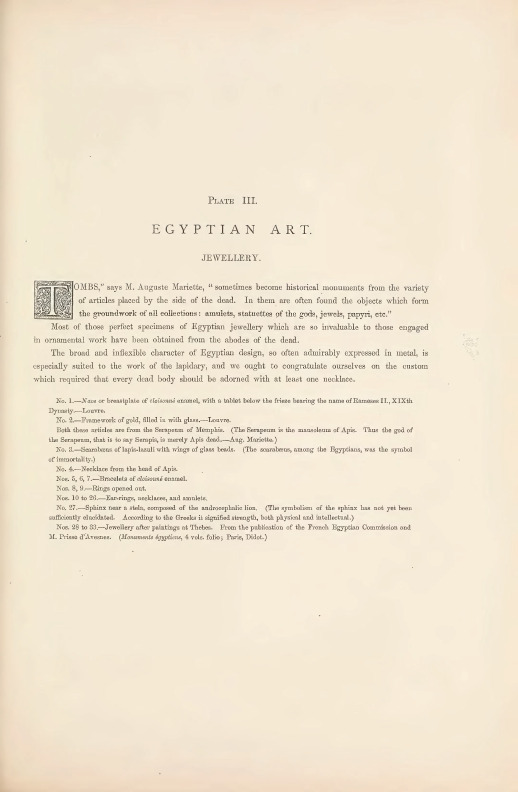
Albert Racinet - L’Ornement Polychrome
PLATE III
EGYPTIAN ART.
JEWELLERY.
"TOMBS,'' says M. Auguste Mariette, "sometimes become historical monuments from the variety of articles placed by the side of the dead. In them are often found the objects which form the groundwork of all collections: amulets, statuettes of the gods, jewels, papyri, etc."
Most of those perfect specimens of Egyptian jewellery which are so invaluable to those engaged in ornamental work have been obtained from the abodes of the dead.
The broad and inflexible character of Egyptian design, so often admirably expressed m metal, is especially suited to the work of the lapidary, and we ought to congratulate ourselves on the custom which required that every deacl body should be adorned with at least one necklace.
No. l.-Naos or breastplate of cloisonne enamel, with a tablet below the frieze bearing the name ofRameses II., XIXth Dynasty.-Louvre.
No. 2.-Framework of gold, filled in with glass.-Louvre.
Both these articles are from the Serapeum of Memphis. (The Serapeum is the mausoleum of A.pis. Thus the god of the Serapeum, that is to say Serapis, is merely A.pis dead.-A.ug. Mariette.)
No. 3.-Scarabams of lapis-lazuli with wings of glass beads. (The scarabams, among the Egyptians, was the symbol of immortality.)
No. 4.-Necklace from the head of A.pis.
Nos. 5, 6, 7 -Bracelets of cloisonne enamel.
Nos. 8, 9,-Rings opened out.
Nos. 10 to 26.-Ear-rings, necklaces, and amulets.
No. 27 .-Sphinx near a stela, composed of the androcephalic lion. (The symbolism of the sphinx has not yet been sufficiently elucidated. According to the Greeks it signified strength, both physical and intellectual.)
Nos. 28 to 33,-Jewellery after paintings at Thebes. From the publication of the French Egyptian Commission and 1I. Prisso d'Avesnes. (Monuments egyptiens, 4 vols. folio; Paris, Diclot.)
#Albert Racinet#antiquity#ancient history#ancient art#ancient egypt#1800s#1800s art#illustration#art#cultural art#smithsonian#smithsonian library
8 notes
·
View notes
Text

The Temple of Edfu was buried under centuries of sand and silt until the nineteenth century, when French Egyptologist Auguste Mariette rediscovered the site. The complex is one of the most well-preserved sites in Egypt today; its architecture is very much intact, and the building contains a wealth of legible inscriptions on its walls. It is dedicated to the falcon god, Horus.
The temple was built on top of much older ruins dating back to Ramses III, and was constructed over the course of 180 years under a variety of rulers during the Ptolemaic period in Egypt.
- 🪲
3 notes
·
View notes
Text


Recompiled by SCTJM
"I am the Virgin of the Poor...Believe in Me, I will believe in you!"
Eight apparitions to the young girl Mariette Beco January 15 - March 2, 1933, Belgium.
Approved by the Holy See on August 22, 1949
Twelve days after Our Lady of Beauraing the Lady with the Golden Heart said "Goodbye" to five children in Beauraing, Belgium, she made her presence felt again in Banneux, Belgium, some fifty miles to the northeast, to Mariette Beco, known as Our Lady of Banneux.
[the rest of the story here]
2 notes
·
View notes
Photo

Eté 1894 - Champs-les-Sims
12/12
Mon cousin Constantin m’envoie très régulièrement des lettres depuis son pensionnat. Si il ne s’entend guère avec ses camarades et s’oppose souvent aux visions religieuses de ses professeurs, il est, comme l’avait prévu Oncle Maximilien, l’un des meilleurs élèves. Il s’est enfin trouvé une vocation semblerait-il. En effet, il m’a raconté de façon très détaillée les dix volumes qu’il a trouvé dans la bibliothèque de l’école, rempli d’illustrations réalisées par des savants que Napoléon ont réalisé pendant la campagne d’Egypte. Il ne me parle depuis plus que d’égyptologie et des noms comme Gaston Maspero ou Auguste Mariette sont devenus très familiers. Dès que je peux, je lui commande des ouvrages des maîtres pour qu’il puisse les lire sur son temps libre. Je lui ai du coup parlé du départ de votre frère Jules pour l’Egypte, et il ne cesse de me poser des questions à son sujet. Pensez vous que cela dérangerait votre frère de nous écrire des lettres pour nous raconter son voyage ? J’avoue que les filles et moi-même sommes aussi curieux.
Cette passion dévorante est apparue peu de temps après la disparition de son père, et je ne pense que pas que ce soit une coïncidence. Il a toujours été compliqué pour mon cousin d’exprimer ses émotions et si il se réfugiait autrefois dans les romans de Jules Verne, il s’est pour moi trouvé un expédient plus puissant. Je me réjouis cependant pour lui, car appliqué comme il est, il deviendra sans aucun doute un éminent professeur.
Passez donc mes salutations à toute votre famille et mes félicitations à votre frère et à sa nouvelle épouse.
Avec l’expression de mes sentiments les plus distingués,
Votre Cousin, Adelphe Barbois
#lebris#lebrisgens4#legacy challenge#decades challenge#history challenge#nohomechallenge#ts3#Sims 3#Sims Stories#simblr#Adelphe Barbois#Virgile Le Bris#Constantin Le Bris#Maximilien Le Bris#Jules Le Bris#Eugénie Bernard#Rose Le Bris#Juliette Le Bris
9 notes
·
View notes
Text

Estatua del príncipe Shesonq
Fecha: 874–850 a.C.
Tipo de objeto: escultura
Medio, técnica: caliza
Dimensiones: 105 x 32 x 71 cm
Numero de inventario: 51.2050
Colección: Arte egipcio, Museum of fine arts, Budapest
El descubrimiento del Serapeum, la tumba de los toros Apis en Saqqara, en 1851 fue la primera gran sensación en la arqueología egipcia. El comisario del proyecto, Auguste Mariette de Francia, encontró la estatua del príncipe hereditario Sheshonq, hijo del faraón Osorkon II (Dinastía XXII, último cuarto del siglo X a. C.) y el primer cónyuge real Karamama, en el llamado " pequeñas galerías subterráneas ”a principios de 1852. El príncipe arrodillado sostiene ante él al dios con cabeza de halcón Ptah-Sokar-Osiris, venerado en la necrópolis de Saqqara, ubicado en el nicho de un pequeño santuario (naos). La "cerradura lateral juvenil" en el lado derecho de la peluca rizada indicaba la corta edad del príncipe y expresaba su origen real. Debido a su temprana muerte, Sheshonq no pudo convertirse en faraón. Sin embargo, su padre le otorgó el oficio de sumo sacerdote, que está escrito en la inscripción y está indicado por la túnica con estrellas que cubren su espalda. Como sumo sacerdote de Ptah en Memphis, participó en el rito funerario de un toro Apis en el Serapeum en el año 23 del reinado de su padre, Osorkon II. El texto inscrito en el pilar posterior comienza con una solicitud dirigida a Osiris-Apis, el nombre de Apis que se unió con Osiris, el gobernante del próximo mundo, después de su muerte, para proporcionar ofrendas en el más allá. La estatua más cercana a esta se puede ver en la exposición egipcia en el Kunsthistorisches Museum, Viena: probablemente representa al príncipe y también solía estar en el Serapeum. Como sumo sacerdote de Ptah en Memphis, participó en el rito funerario de un toro Apis en el Serapeum en el año 23 del reinado de su padre, Osorkon II. El texto inscrito en el pilar posterior comienza con una solicitud dirigida a Osiris-Apis, el nombre de Apis que se unió con Osiris, el gobernante del próximo mundo, después de su muerte, para proporcionar ofrendas en el más allá. La estatua más cercana a esta se puede ver en la exposición egipcia en el Kunsthistorisches Museum, Viena: probablemente representa al príncipe y también solía estar en el Serapeum. Como sumo sacerdote de Ptah en Memphis, participó en el rito funerario de un toro Apis en el Serapeum en el año 23 del reinado de su padre, Osorkon II. El texto inscrito en el pilar posterior comienza con una solicitud dirigida a Osiris-Apis, el nombre de Apis que se unió con Osiris, el gobernante del próximo mundo, después de su muerte, para proporcionar ofrendas en el más allá. La estatua más cercana a esta se puede ver en la exposición egipcia en el Kunsthistorisches Museum, Viena: probablemente representa al príncipe y también solía estar en el Serapeum.
István Nagy
Información e imagen de la web del museo.
9 notes
·
View notes
Text
As I reading "The Snake, The Crocodile and The Dog", another Amelia Peabody mystery, I feel I should point out that there are several people mentioned in the story who were very real and important in the field of archaeology.
Gaston Maspero (M. Maspero)- he was a leading Egyptologist, who specialised in Egyptian language. In November 1880 Maspero went to Egypt as head of an archeological mission sent there by the French government, which ultimately developed into the well-equipped Institut Français D'archéologie Orientale. Upon the death of Egyptologist Auguste Mariette in 1881, M. Maspero took on the role as director-general of excavations and of the antiquities of Egypt. In 1882, he discovered the tomb of Amenemhet I.
Emerson's "rival", Petrie, was actually a very important person in the field of Egyptology. Flinders Petrie was a British Egyptologist and Archaelogist, whose contributions greatly influenced both fields, and their establishment as scientific disciplines. Petrie is best known for creating a system of relative dating using pottery styles called "seration".
Also mentioned, briefly, was the "square-jawed, clean-shaven American named Reisner". They are referring to George Reisner. He was an Egyptologist and Archaeologist as well as the director of the Harvard-Museum of Fine Arts, Boston expedition. His work was extensive and he made contributions to the fields of Egyptology and Archaeology. He dedicated his life to bringing the beauty of Ancient Egypt to life. He kept meticulous records of every object found. His work still lives on throughout the world through his documentation, which has allowed the findings in Egypt to be disseminated throughout the world.
Also mentioned in the book, however briefly, is a chap named Lepsius: “Especially in view of the fact that Lepsius mentions seeing such tombs in 1843.”
Lepsius is Karl Richard Lepsius, a German Egyptologist whose many contributions helped establish the scientific field of Egyptology. Lepsius led the Prussian Expedition to Egypt and Nubia (Syria) between 1842-1845. The main outcome of this expedition was "Denkmäler aus Ägypten und Äthiopien" (a collection of plans, maps, and drawings of Ancient Egyptian tomb and temple walls). This was Lepsius's greatest legacy. He had also been a Professor of Egyptology at Berlin University and a co-director of the Egyptian Museum in Berlin.

#elizabeth peters#amelia peabody#Amelia Peabody Mysteries#historical fiction#books#reading amelia#currently reading#egyptian themed mysteries#egyptologists#archæology#Karl Richard Lepsius#George Reisner#Gaston Maspero#Flinders Petrie#archaeology mysteries#famous Egyptologists#Harvard-MFA#mystery books#Emerson and Peabody#The Snake The Crocodile and The Dog#Barbara Mertz#Egyptology
2 notes
·
View notes
Text
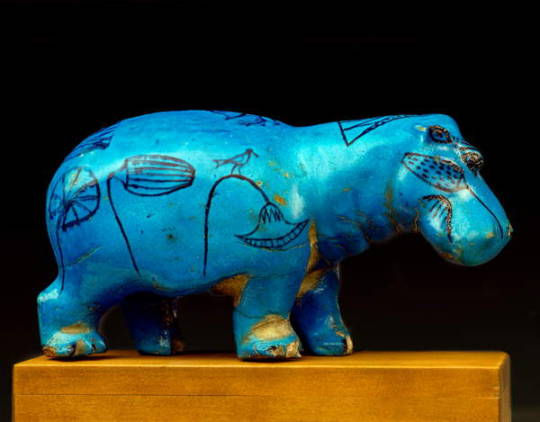
Statuette of a Hippo
Middle Kingdom, 11th Dynasty, ca. 2134-1991 BC.
Made of Egyptian faience. Height 11.5 cm, length 21.5 cm.
Excavated by Auguste Mariette (1860).
Now in the Egyptian Museum, Cairo. JE 21365
This faience hippo statuette was found in Dra’ Abu el-Naga’ in western Thebes. The glossy blue glaze is the color of the Nile, where the animal lived, and the decoration shows various representations of fauna and flora that grew by the river.
The flowers, papyrus plants, and perching birds are depicted in black, linear forms. Such animal figurines were popular in tombs of the Middle Kingdom and the Second Intermediate Period. The hippopotamus was associated with the fertility of the Nile mud or silt.
Read more
51 notes
·
View notes
Text
ITALIAN MUSIC
Aida: Celeste Aida
To celebrate 300 followers, here I come with a new translation project; namely, for Italian songs.
I decided to start with lyrical music, which, next to popular songs, are the oldest I could find, to gradually move on to more recent times.
The aria I'll translate in this post comes from the Aida. A four-act opera by Giuseppe Verdi on a libretto by Antonio Ghislanzoni. It was commissioned by Ismail Pasha, khedivè of Egypt, with intercession by Auguste Mariette, first director of the Egyptian Museum of Cairo, in the occasion of the opening of the Suez Canal.
The plot goes as follows: Ethiopian princess Aida has been captured during an Egyptian campaign against her country, but nobody knows her actual rank and considers her just a serving girl. Her father is planning to invade Egypt to retrieve her,but she has fallen in love with the young Egyptian commander Radames. This guy is chosen to be the one to lead Egypt's army against Amonasro, Aida's father, leaving the poor girl torn between the love for her father and country and that for her lover; in the meantime, she is tormented by Amneris' the Pharaoh's daughter, who is also in love with Radames.
The Egyptian general wins the battle, and shows up with Ethiopian prisoners among whomst, unknown to everyone, is Amonasro. He manages to convince the Pharaoh to concede liberty to the war prisoners, except for Aida and Amonasro as hostages. But during a private conversation with Aida, he ends up revealing her information on the position of the Egyptian troops; Aida and her father escape, and Radames is left there believing he has betrayed his king and country. He is sentenced to death by being buried alive, but Aida reaches him to share his sentence; the two lovers accept to die together renewing their feelings for each other, and Amneris is left in tears on their grave.
This aria come from the first act; sung bt Radames, about his desire to be the general and prove himself to everyone - and especially Aida.
Se quell guerrier io fossi
Were I that warrior
Se il mio sogno si avverasse
Were my dream to come true
Un esercito di prodi da me guidato
An army of braves led by me
e la vittoria e il plauso di Menfi tutta
and victory and praise from all of Memphis
E a te, mia dolce Aida
And to you, my sweet Aida
Tornar di lauri cinto
Return crowned in laurel
Dirti: per te ho pugnato per te ho vinto
Tell you: for you I fought for you I won
Celeste Aida, forma divina
Heavenly Aida, divine form
Mistico serto di luce e fior
Mystic crown of light and flowers
Del mio pensiero tu sei regina
You are the queen of my thought
Tu di mia vita sei lo splendor
You are the splendor of my life
Il tuo bel cielo vorrei ridarti
I'd like to give back to you your beautiful sky,
Le dolci brezze del patrio suol
The sweet breezes of your native land
Un regal serto sul crin posarti
To place a royal crown on your head
Ergerti un trono vicino al sol, ah
To build you a throne next to the sun
Celeste Aida, forma divina
Heavenly Aida, divine form,
Mistico raggio di luce e fior
Mystic ray of light and flowers
Del mio pensiero tu sei regina
You are the queen of my thought
Tu di mia vita sei lo splendor
You are the splendor of my life
Il tuo bel cielo vorrei ridarti
I'd like to give back to you your beautiful sky
a throne next to the sun
Le dolci brezze del patrio suol
the sweet breezes of the native land
Un regal serto sul crin posarti
to place a royal crown on your head
Ergerti un trono vicino al sol
To build you a throne next to the sun
Un trono vicino al sol
A throne next to the sun
Un trono vicino al sol
a throne next to the sun
Check the reblogs to hear the music, because this hellsite of Tumblr doesn't show posts in the tags if there are external links.
6 notes
·
View notes